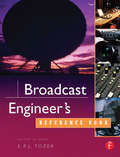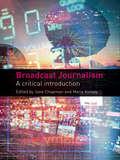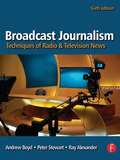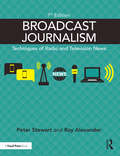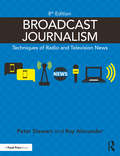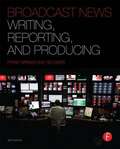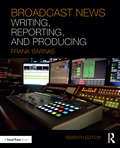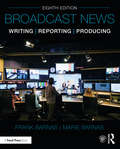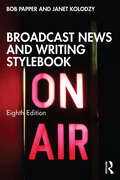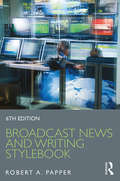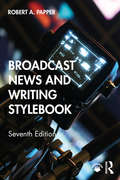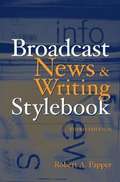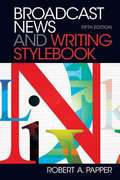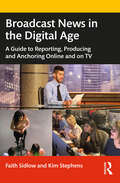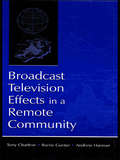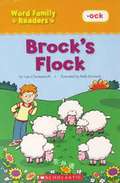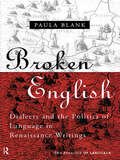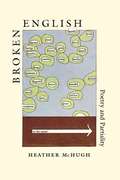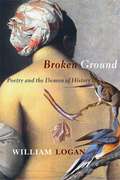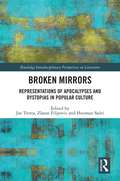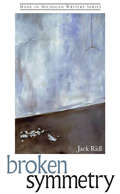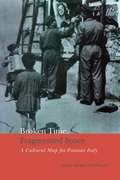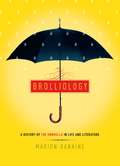- Table View
- List View
Broadcast Engineer's Reference Book
by E.P.J. TozerThe current and definitive reference broadcast engineers need!Compiled by leading international experts, this authoritative reference work covers every aspect of broadcast technology from camera to transmitter - encompassing subjects from analogue techniques to the latest digital compression and interactive technologies in a single source.Written with a minimum of maths, the book provides detailed coverage and quick access to key technologies, standards and practices. This global work will become your number one resource whether you are from an audio, video, communications or computing background. Composed for the industry professional, practicing engineer, technician or sales person looking for a guide that covers the broad landscape of television technology in one handy source, the Broadcast Engineer's Reference Book offers comprehensive and accurate technical information. Get this wealth of information at your fingertips!· Utilize extensive illustrations-more than 1200 tables, charts and photographs.· Find easy access to essential technical and standards data.· Discover information on every aspect of television technology.· Learn the concepts and terms every broadcaster needs to know.Learn from the experts on the following technologies:Quantities and Units; Error Correction; Network Technologies; Telco Technologies; Displays; Colourimetry; Audio Systems; Television Standards; Colour encoding; Time code; VBI data carriage; Broadcast Interconnect formats; File storage formats; HDTV; MPEG 2; DVB; Data Broadcast; ATSC Interactive TV; encryption systems; Optical systems; Studio Cameras and camcorders; VTRs and Tape Storage; Standards Convertors; TV Studios and Studio Equipment; Studio Lighting and Control; post production systems; Telecines; HDTV production systems; Media Asset Management systems; Electronic News Production Systems; OB vehicles and Mobile Control Rooms;ENG and EFP; Power and Battery Systems; R.F. propagation; Service Area Planning; Masts Towers and Antennas; Test and measurement; Systems management; and many more!Related Focal Press titles:Watkinson: Convergence In Broadcast and Communications Media (2001, £59.99 (GBP)/ $75.95 (USD), ISBN: 0240515099) Watkinson: MPEG Handbook (2001, £35 (GBP)/$54.99 (USD) ISBN: 0240516567)
Broadcast Journalism: A Critical Introduction
by Jane Chapman Marie KinseyBroadcast Journalism offers a critical analysis of the key skills required to work in the modern studio, on location, or online, with chapters written by industry professionals from the BBC, ITV, CNN and independent production companies in the UK and USA. Areas highlighted include: interviewing researching editing writing reporting. The practical tips are balanced with chapters on representation, ethics, law, economics and history, as well as specialist areas such as documentary and the reporting of politics, business, sport and celebrity. Broadcast Journalism concludes with a vital chapter on career planning to act as a springboard for your future work in the broadcast industry. Contributors: Jim Beaman; Jane Chapman; Fiona Chesterton; Tim Crook; Anne Dawson; Tony Harcup; Jackie Harrison; Ansgard Heinrich; Emma Hemmingway; Patricia Holland; David Holmes; Gary Hudson; Nicholas Jones; Marie Kinsey; Roger Laughton; Leslie Mitchell; Jeremy Orlebar; Claire Simmons; Katie Stewart; Ingrid Volkmer; Mike Ward; Deborah Wilson.
Broadcast Journalism: Techniques of Radio and Television News
by Andrew Boyd Ray Alexander Peter StewartThis newest edition of Broadcast Journalism continues its long tradition of covering the basics of broadcasting from gathering news sources, interviewing, putting together a programme, news writing, reporting, editing, working in the studio, conducting live reports, and more. Two new authors have joined forces in this new edition to present behind the scenes perspectives on multimedia broadcast news, where it is heading, and how you get there. Technology is meshing global and local news. Constant interactivity between on-the-scene reporting and nearly instantaneous broadcasting to the world has changed the very nature of how broadcast journalists must think, act, write and report on a 24/7 basis. This new edition takes up this digital workflow and convergence. Students of broadcast journalism and professors alike will find that the sixth edition of Broadcast Journalism is completely up-to-date.Includes new photos, quotations, and coverage of convergent journalism, podcasting, multimedia journalism, citizen journalism, and more!
Broadcast Journalism: Techniques of Radio and Television News
by Ray Alexander Peter StewartThis seventh edition of Broadcast Journalism continues its long tradition of covering the basics of broadcasting from gathering news sources, interviewing, putting together a programme, news writing, reporting, editing, working in the studio, conducting live reports and more. The authors have brought the material further up to date with the integration of social media, uses of mobile technology, the emergence of user-generated content and updated examples, illustrations and case studies throughout. End-of-chapter exercises are also included. New for this edition: Updated with new examples, quotes and pictures. Restructured with end-of-chapter summaries, exercises for students, notes for tutors, links for further reading and references to invaluable websites and smartphone apps. Extended chapters on ethics, responsibilities, interviewing, mobile newsgathering and filming. New additional information on coping with reporting traumatic stories, and how news organisations use Twitter and Periscope.
Broadcast Journalism: Techniques of Radio and Television News
by Ray Alexander Peter StewartNow in its 8th edition, Broadcast Journalism continues to be an essential text on the production of news broadcasting and the practical skills needed. It includes not only basic techniques and classic examples for the production of radio and TV news, but also new technology and the latest case studies. The fundamental skills of interviewing, news writing and production now have to cope with the prevalence of Fake News and Deep Fakes and verifying content in an endless flow of social media. This edition also includes newsgathering with mobile devices, live reporting and using data and graphics. There are dozens of new images and links for downloads and further reading, plus end-of-chapter exercises and tutor notes. This continues to be an indispensable textbook for broadcast journalism and communications students looking for an in-depth guide to the industry.
Broadcast News Writing, Reporting, and Producing
by Frank BarnasJargon buster: convergent journalism: ?Media convergence is the most significant development in the news industry in the last century. The ability to interchange text, audio, and visual communication over the Internet has fundamentally transformed the way news organizations operate. Convergence has enabled media companies to gather, disseminate, and share information over a variety of platforms. Throughout the history of journalism, it has been common for journalists to study one medium, such as traditional print or broadcast, and to anticipate a career working only in their chosen field. However, the 21st century journalist has fluidity to write and deliver news content in a variety of formats. (source: http://www.convergencejournalism.com/) Broadcast News Writing, Reporting, and Producing presents a solid foundation for any student learning how to become a broadcast journalist ? in today's world of convergent journalism, it is more important than ever that broadcast textbooks cover the most current trends in media. Convergent journalism (the coverage of news across multiple delivery platforms such as the internet, television, podcasts, ipods, blogs, etc) is here to stay ? broadcast journalism continues to morph as newer and more advanced content platforms are hatched and developed, and broadcast journalists must understand how to write, report, and produce for multiple platforms simultaneously. Just one crucial fact remains: students will need training on how to perform successfully in a world in which current events aren't just shown on the ten o'clock evening news.Broadcast News Writing, Reporting, and Producing will be completely overhauled to reflect the trends of convergent journalism on every page. New co-author Frank Barnas brings a multi-faceted perspective of writing, reporting, and producing that allows for multi-platform delivery systems, and shows students with real-world examples the functions and practices of today's media. The new edition will be rewritten and restructured to accommodate common 16-week course modules, and will be divided into four major sections of the news: gathering, writing, reporting, and producing. Sidebars featuring how examples used in the text relate to convergence in journalism help students to draw connections easily between current stories and trends in the industry. The comprehensive approach of this text brings a multi-faceted perspective of writing, reporting, and producing that is needed more than ever in today's world of convergent journalism. This newest edition is being completely overhauled by the experienced journalist Frank Barnas. New photos and illustrations, a restructuring of the text, expanded end-of-chapter exercises, newer and more relevant examples, and more information on producing all contribute to giving readers what they need most: a nuanced understanding of how the media of today function in a world without news boundaries.
Broadcast News Writing, Reporting, and Producing
by Frank BarnasBroadcast News Writing, Reporting, and Producing, 7th Edition is the leading book covering all aspects of writing and reporting the news. It identifies the key concepts and terms readers need to know in the news gathering and dissemination process, and provides practical, real-world advice for operating in the modern day newsroom. New to the seventh Edition are profiles of working journalists who give readers a glimpse into the working life of modern reporters, producers, and directors. This new edition also covers important aspects of the use of social media, drone journalism, and digital technology. A new chapter on portfolio development will assist readers in developing the skills to advance in their careers. The text has also been updated to reflect new industry standards in modes of information gathering and delivery, writing style, and technology. Additional features include: Key words at the start of every chapter, identifying important terms and definitions; End of chapter summaries, which allows readers to review the chapter’s main points; "Text Your Knowledge", which helps readers quiz themselves on important concepts; Chapter-by-chapter exercises, which readers can apply to a chapter’s themes; A companion website featuring video tutorials of necessary skills for journalists, including how to arrange lighting structures, how to hold a microphone, and how to properly conduct an interview.
Broadcast News Writing, Reporting, and Producing
by Frank Barnas Marie BarnasNow in its eighth edition, Broadcast News Writing, Reporting, and Producing is the industry’s leading textbook covering all aspects of the three pillars of broadcast news. The book discusses the key strategies and terms of newsgathering and delivery by providing real-world, professional advice for broadcast journalists in the modern-day newsroom. New to the eighth edition is the Best Apps feature, which identifies the most productive apps used by working journalists when covering stories. The book also covers the ever increasing diversity of the journalism field and brings in new voices from professionals working in the industry to discuss these topics. Other new additions include in-depth discussions of fake news, expanded coverage of social media in the newsroom, and an overview of the latest advances in technology available to television and radio news reporters. Broadcast News Writing, Reporting, and Producing remains the best book for undergraduate students in journalism writing, producing, newsgathering, and multimedia courses. An accompanying companion website features resources to help instructors deliver online courses, including Powerpoints, Quizlets, and a sample syllabus.
Broadcast News and Writing Stylebook
by Janet Kolodzy Bob PapperBroadcast News and Writing Stylebook is the go-to resource for writing broadcast news, offering a concise introduction to writing engaging stories for television, radio, podcasts and online media.Covering the nuances of reporting, grammar, style and usage, readers will learn how to craft stories on government, crime, weather, education, health, sports and more. This eighth edition is updated to include: New sections on industry challenges and opportunities from artificial intelligence, deepfakes and streaming. Fully updated examples, exercises and glossary. An expanded focus on ethics with ethical issues discussed in virtually every chapter. Drawing on over a quarter of a century of broadcast news and industry research experience, authors Papper and Kolodzy once again ensure this vital text contains all the information necessary for being a successful news writer today.Whether you’re a journalism student or a working broadcast professional, Broadcast News and Writing Stylebook is a definitive reference for your bookshelf.This book also features an accompanying Instructor Manual, found at www.routledge.com/9781032519845
Broadcast News and Writing Stylebook
by Robert A. PapperPapper’s Broadcast News and Writing Stylebook is the go-to handbook in broadcast news, and with the updates in the 6th edition, it is sure to continue this legacy. Through clear and concise chapters, this text provides the fundamental rules of broadcast news writing. It covers various fields across the board, including crime and government, weather, education, health, and sports. Within each field, readers learn the nuances of reporting, grammar, style, and usage. Written by a professional who has overseen major industry research for the past 23 years, this edition presents the data on news writing in a relevant and digestible manner. With the business of broadcast news changing rapidly, this text reflects the current news environment and explores where it will head in the future. With an expanded social media chapter and additional insight into the news rooms of today, Broadcast News and Writing Stylebook incorporates all the skills and knowledge reporters and journalist need to prepare for their careers.
Broadcast News and Writing Stylebook
by Robert A. PapperBroadcast News and Writing Stylebook is the go-to resource for writing broadcast news, offering readers the know-how to write excellent stories for television, radio, podcasts and online media. Through clear and concise chapters, this text provides the fundamental rules of broadcast news writing, teaching readers how to craft stories on government, crime, weather, education, health, sports and more. It covers the necessary mechanics news writers need to know, including the nuances of reporting, grammar, style and usage. This new seventh edition is updated with the latest on how stations incorporate online and social media strategies, as well as insights into the directions local news is headed. Author Robert A. Papper has over a quarter century of broadcast news and industry research experience and once again updates this vital text with the information necessary for being a successful news writer today. Also available for this edition is an Instructor’s Guide, found on the book’s webpage. Whether you’re a student seeking to learn the mechanics of successful broadcast news writing or a working professional looking for a definitive reference for your desk, Broadcast News and Writing Stylebook offers a comprehensive guide to writing for television, audio and beyond.
Broadcast News and Writing Stylebook (3rd edition)
by Robert A. PapperAlthough this book focuses on writing, it takes as a given the reader's acceptance of the basic tenets of broadcast journalism: to be accurate, fair, clear and interesting. Accurate because no manner of clever word weaving recompenses wrongful injury to the people we cover or the self-inflicted damage of a correction that could have been avoided. Fair if we are to be trusted. Clear be¬cause without clarity what we do has no meaning. Interesting because it really doesn't matter what we do if no one's out there listening and watching.
Broadcast News and Writing Stylebook -- Pearson eText
by Robert A. PapperUpdated in its 5th edition, Papper's Broadcast News and Writing Stylebook is the first and most widely used handbook in broadcast news. This book clearly and concisely outlines the rules of broadcast news writing, reporting, grammar, style, and usage. With chapter-by-chapter coverage of story types, from business stories to crime and legal reporting, education, government, health, the environment, weather, and sports, the Broadcast News and Writing Stylebook lays out the particular demands of composition, form, style, and usage in all the diverse areas of broadcast news. Because the news business has changed -- and continues to evolve -- so has this text.Written by the person who has overseen the major industry research for the past 18 years, the latest edition looks into the future of news by exploring the business of news. Citing the latest data and trends, the book takes a hard look at where the industry stands and where it appears to be headed.
Broadcast News in the Digital Age: A Guide to Reporting, Producing and Anchoring Online and on TV
by Kim Stephens Faith M SidlowWritten by two award-winning broadcast journalists, this book offers a practical, hands-on guide to the modern digital TV newsroom. Pulling from extensive industry experience, the authors provide a comprehensive look at the key journalistic skills needed to excel in broadcast news today, including storytelling, writing, story pitching, video production, interviewing and managing social media. The textbook is organized into five sections: building a foundation, storytelling and writing, producing, live performance, and ethics and career progression. The authors also provide step-by-step instructions on how to efficiently multitask while staying true to journalist ethics. Each chapter includes clear learning objectives, review questions and practical assignments, making it ideal for classroom use. QR codes integrated in the text allow students to easily see and hear examples of the stories they are learning to write. Broadcast News in the Digital Age is an engaging, student-friendly guide for those seeking to become successful writers, producers, anchors and journalists in today’s newsrooms, both on-air and online.
Broadcast Television Effects in A Remote Community (Routledge Communication Series)
by Barrie Gunter Tony Charlton Andrew HannanThis book reports findings from a major, multidisciplinary study of the impact of broadcast television on the remote island community of St. Helena in the South Atlantic Ocean. Broadcast television was introduced to the island for the first time in March 1995. This introduction represented a major event on the island, whose only televisual experience had been through video. In the years leading up to the introduction of TV, the researchers who wrote this book collected data by observing the island's young children in classroom settings, and during free-play. In addition to these observations they asked the children's teachers to rate their students' behavior, and invited the children to explain to them what leisure time activities they engaged in. With the data they were able to amass on these key variables they have assembled and coded the results into baseline measures central to the study. Once TV had arrived, they collected data annually on the key dependent measures to determine if the introduction of broadcast TV had any discernible influence on the behavior of the children.
Brock's Flock (Word Family Readers)
by Liza CharlesworthBrock's flock lives in a giant sock! Learn more shocking facts about his flock in this silly story that teaches lots and lots of -ock words! Let's Learn Readers boost key literacy skills through engaging, easy-to-read stories. Share this super-fun book with your child to jumpstart phonics learning!
Broken English: Dialects and the Politics of Language in Renaissance Writings (The Politics of Language)
by Paula BlankThe English language in the Renaissance was in many ways a collection of competing Englishes. Paula Blank investigates the representation of alternative vernaculars - the dialects of early modern English - in both linguistic and literary works of the period. Blank argues that Renaissance authors such as Spenser, Shakespeare and Jonson helped to construct the idea of a national language, variously known as 'true' English or 'pure' English or the 'King's English', by distinguishing its dialects - and sometimes by creating those dialects themselves. Broken English reveals how the Renaissance 'invention' of dialect forged modern alliances of language and cultural authority. This book will be of interest to scholars and students of Renaissance studies and Renaissance English literature. It will also make fascinating reading for anyone with an interest in the history of English language.
Broken English: Poetry and Partiality
by Heather Mchugh"When I call poetry a form of partiality," writes Heather McHugh, "I mean its economies operate by powers of intimation: glimmering and glints, rather than exhaustible sums. It is a broken language from the beginning, brimming with non-words: all that white welled up to keep the line from surrendering to the margin; all that quiet, to keep the musics marked." In Broken English, McHugh applies her poetic sensibility and formidable critical insight to topics ranging from the poetry of Valery and Rilke to ancient Greek drama and Yoruba folk songs, offering intense, passionate, highly personal readings that are informed and unified by her concern for the relationships among language, culture, and poetry. Ebook Edition Note: All images have been redacted.
Broken Ground: Poetry and the Demon of History
by William LoganIn Broken Ground, William Logan explores the works of canonical and contemporary poets, rediscovering the lushness of imagination and depth of feeling that distinguish poetry as a literary art. The book includes long essays on Emily Dickinson’s envelopes, Ezra Pound’s wrestling with Chinese, Robert Frost’s letters, Philip Larkin’s train station, and Mrs. Custer’s volume of Tennyson, each teasing out the depths beneath the surface of the page.Broken Ground also presents the latest run of Logan’s infamous poetry chronicles and reviews, which for twenty-five years have bedeviled American verse. Logan believes that poetry criticism must be both adventurous and forthright—and that no reader should settle for being told that every poet is a genius. Among the poets under review by the “preeminent poet-critic of his generation” and “most hated man in American poetry” are Anne Carson, Jorie Graham, Paul Muldoon, John Ashbery, Geoffrey Hill, Louise Glück, John Berryman, Marianne Moore, Frederick Seidel, Les Murray, Yusef Komunyakaa, Sharon Olds, Johnny Cash, James Franco, and the former archbishop of Canterbury.Logan’s criticism stands on the broken ground of poetry, soaked in history and soiled by it. These essays and reviews work in the deep undercurrents of our poetry, judging the weak and the strong but finding in weakness and strength what endures.
Broken Harmony: Shakespeare and the Politics of Music
by Joseph M. OrtizMusic was a subject of considerable debate during the Renaissance. The notion that music could be interpreted in a meaningful way clashed regularly with evidence that music was in fact profoundly promiscuous in its application and effects. Subsequently, much writing in the period reflects a desire to ward off music’s illegibility rather than come to terms with its actual effects. In Broken Harmony Joseph M. Ortiz revises our understanding of music’s relationship to language in Renaissance England. In the process he shows the degree to which discussions of music were ideologically and politically charged. Offering a historically nuanced account of the early modern debate over music, along with close readings of several of Shakespeare’s plays (including Titus Andronicus, The Merchant of Venice, The Tempest, and The Winter’s Tale) and Milton’s A Maske, Ortiz challenges the consensus that music’s affinity with poetry was widely accepted, or even desired, by Renaissance poets. Shakespeare more than any other early modern poet exposed the fault lines in the debate about music’s function in art, repeatedly staging disruptive scenes of music that expose an underlying struggle between textual and sensuous authorities. Such musical interventions in textual experiences highlight the significance of sound as an aesthetic and sensory experience independent of any narrative function.
Broken Mirrors: Representations of Apocalypses and Dystopias in Popular Culture (Routledge Interdisciplinary Perspectives on Literature)
by Joe Trotta Zlatan Filipovic Houman SadriDystopian stories and visions of the Apocalypse are nothing new; however in recent years there has been a noticeable surge in the output of this type of theme in literature, art, comic books/graphic novels, video games, TV shows, etc. The reasons for this are not exactly clear; it may partly be as a result of post 9/11 anxieties, the increasing incidence of extreme weather and/or environmental anomalies, chaotic fluctuations in the economy and the uncertain and shifting political landscape in the west in general. Investigating this highly topical and pervasive theme from interdisciplinary perspectives this volume presents various angles on the main topic through critical analyses of selected works of fiction, film, TV shows, video games and more.
Broken Symmetry: Broken Symmetry
by Jack RidlMichigan poet Jack Ridl leads readers into reflective connection with the everyday world in this unique and enjoyable volume.
Broken Time, Fragmented Space: A Cultural Map of Postwar Italy (The Royal Society of Canada Special Publications)
by Anna Maria TorrigliaBroken Time, Fragmented Space: A Cultural Map for Post-war Italy examines how the artists and intellectuals of post-war Italy dealt with the 'shameful' heritage of their fascist upbringing and education by trying to craft a new cultural identity for themselves and the country. The continuities between the culture of the fascist and post-fascist periods were, however, far greater than what intellectuals were ready to admit, creating an uncomfortable, sometimes schizophrenic relation to time, as a painful urge to erase the past.Drawing on a variety of critical approaches, Torriglia investigates the efforts to reconstruct a personal as well as a collective self by analyzing both canonical and lesser-known cinematic and literary texts. Organized around four main themes - the use of language, the interaction between personal and public spheres, the perceptual categories of history and memory, and the reconstruction of the female identity - the study also includes historical introductions and sociological commentary that provides an extensive and captivating picture of the cultural production in 1950s Italy, a period that has not yet been extensively studied.
Brokering Tareas: Mexican Immigrant Families Translanguaging Homework Literacies
by Steven AlvarezWinner of the 2019 Outstanding Book in Community Writing Award presented by the Coalition for Community WritingBrokering Tareas examines a grassroots literacy mentoring program that connected immigrant parents with English language mentors who helped emerging bilingual children with homework and encouraged positive academic attitudes. Steven Alvarez gives an ethnographic account of literacies practices, language brokering, advocacy, community-building, and mentorship among Mexican-origin families at a neighborhood afterschool program in New York City. Alvarez argues that engaging literacy mentorship across languages can increase parental involvement and community engagement among immigrant families, and offers teachers and researchers possibilities for rethinking their own practices with the communities of their bilingual students.
Brolliology
by Marion RankineA fun, illustrated history of the umbrella's surprising place in life and literatureHumans have been making, using, perfecting, and decorating umbrellas for millennia--holding them over the heads of rulers, signalling class distinctions, and exploring their full imaginative potential in folk tales and novels. In the spirit of the best literary gift books, Brolliology is a beautifully designed and illustrated tour through literature and history. It surprises us with the crucial role that the oft-overlooked umbrella has played over centuries--and not just in keeping us dry. Marion Rankine elevates umbrellas to their rightful place as an object worthy of philosophical inquiry. As Rankine points out, many others have tried. Derrida sought to find the meaning (or lack thereof) behind an umbrella mentioned in Nietzsche's notes, Robert Louis Stevenson wrote essays on the handy object, and Dickens used umbrellas as a narrative device for just about everything. She tackles the gender, class, and social connotations of carrying an umbrella and helps us realize our deep connection to this most forgettable everyday object--which we only think of when we don't have one.
